Номер 16, страница 192 - гдз по английскому языку 11 класс учебник Афанасьева, Михеева
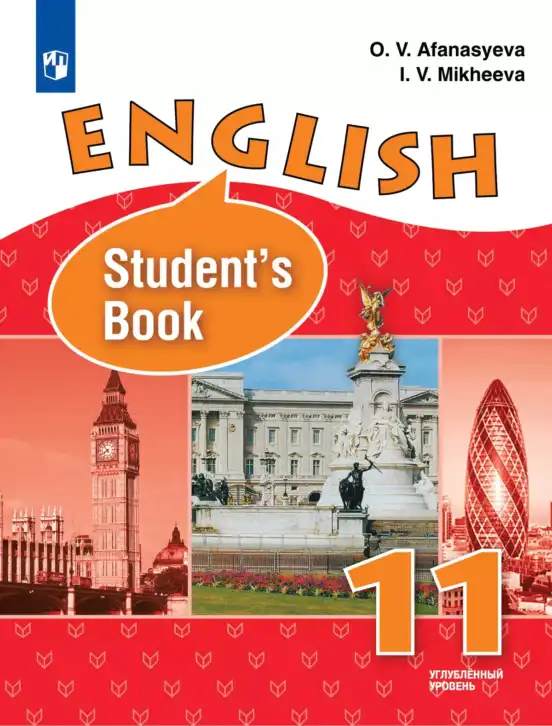
Авторы: Афанасьева О. В., Михеева И. В.
Тип: Student's book (Учебник)
Издательство: Просвещение
Год издания: 2014 - 2025
Уровень обучения: углублённый
Цвет обложки: белый, красный
ISBN: 978-5-09-034233-9
Популярные ГДЗ в 11 классе
Unit Four. Man As the Greatest Wonder of the World. Reading - номер 16, страница 192.
№16 (с. 192)
Условие. №16 (с. 192)
скриншот условия
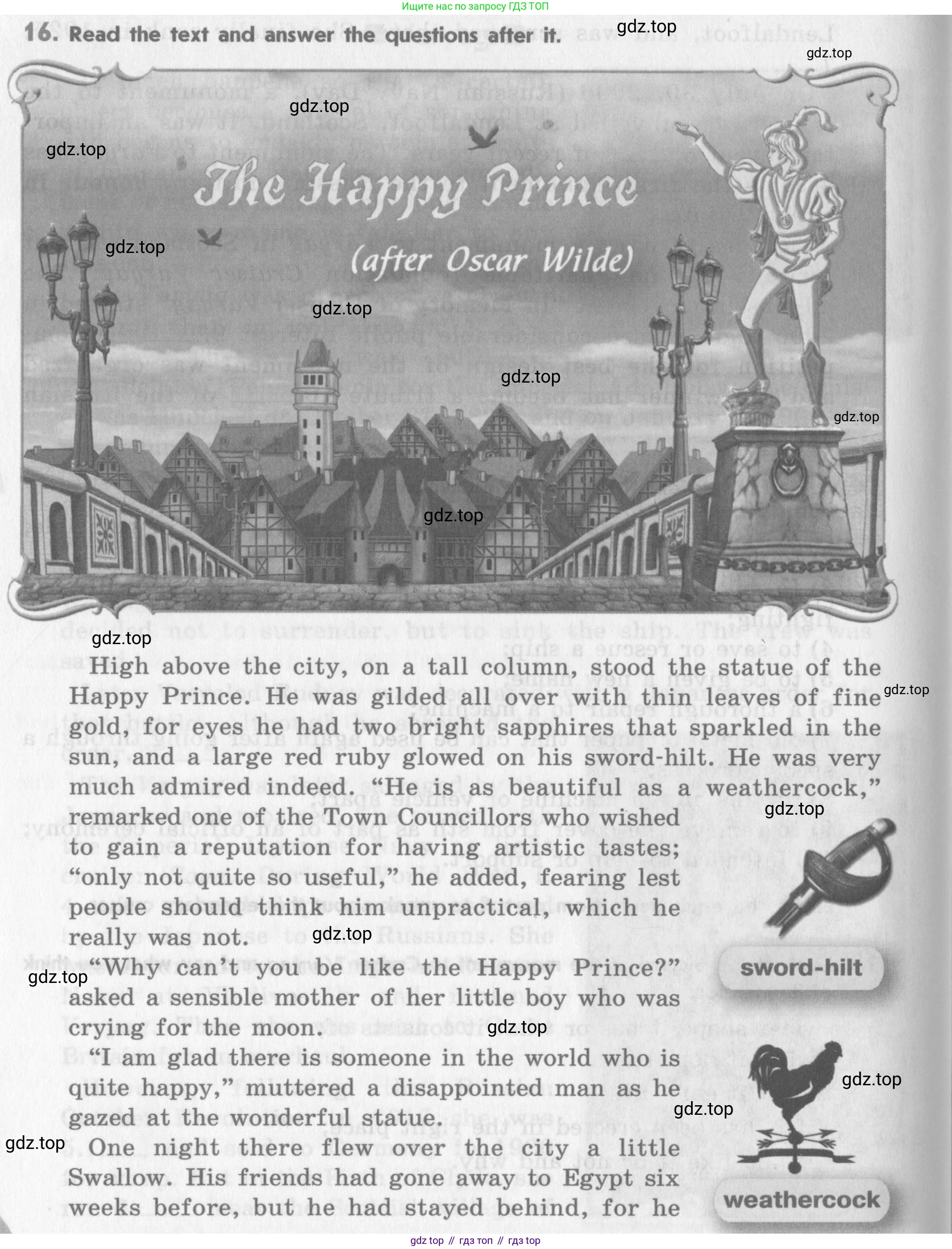
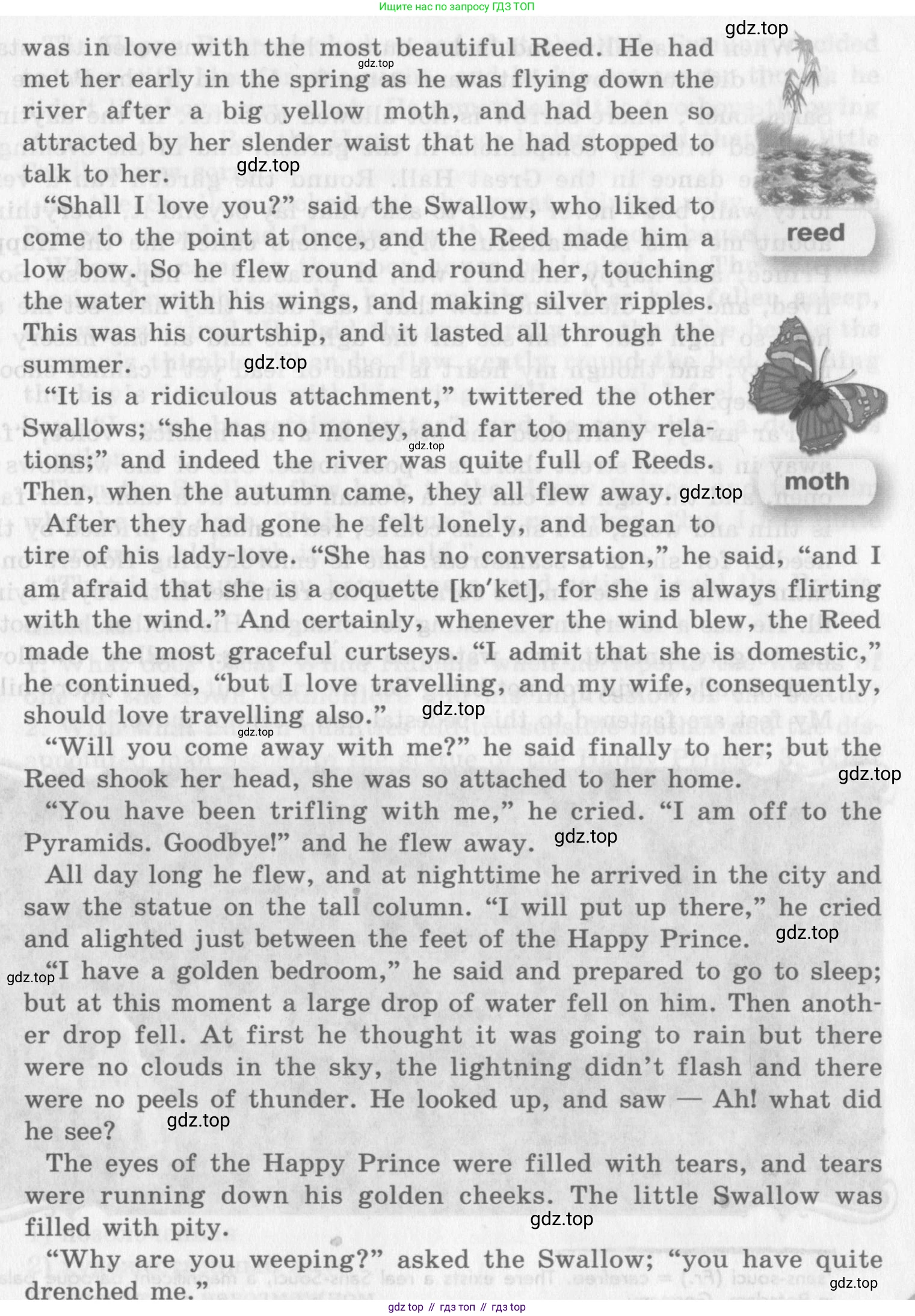
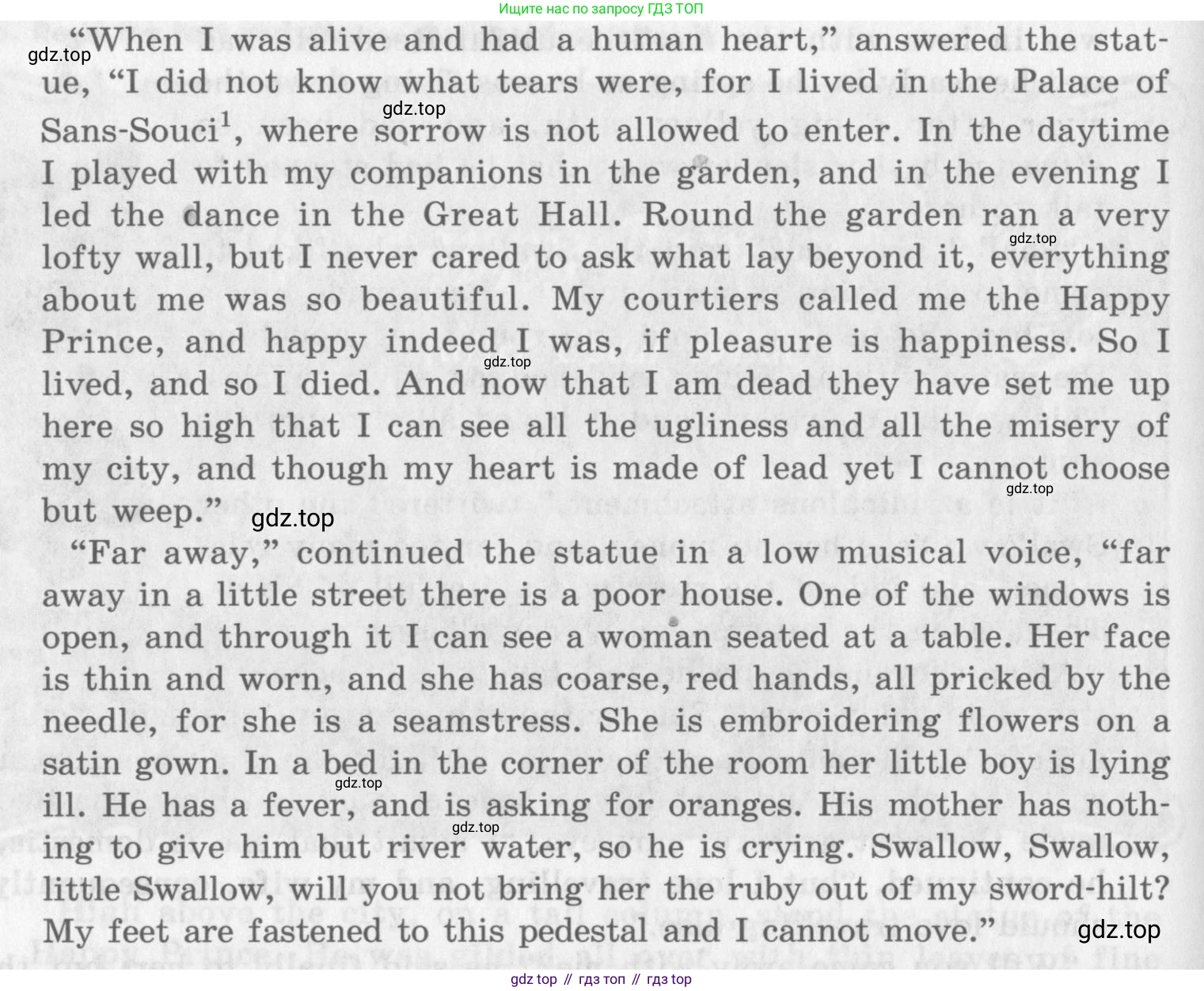
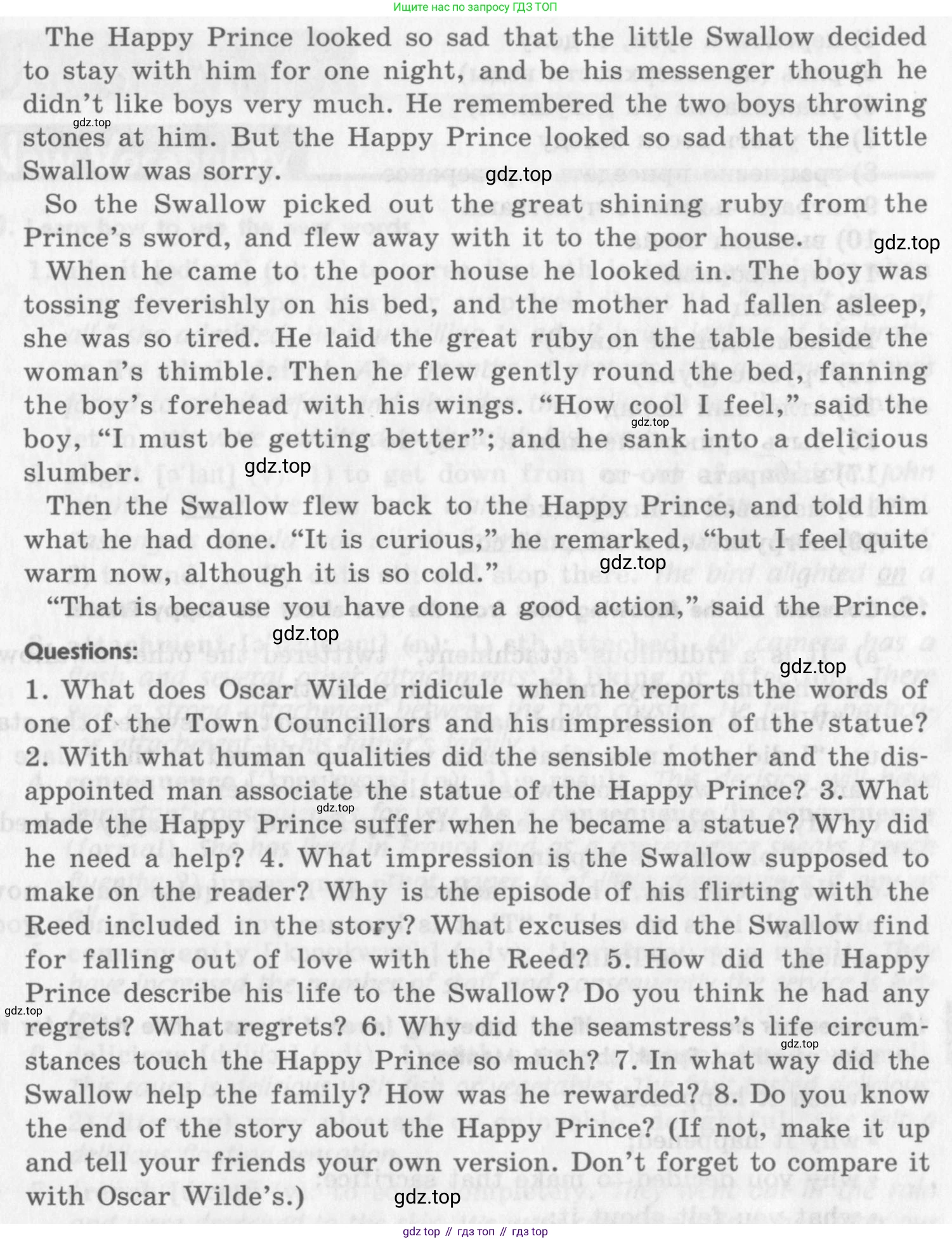
16. Read the text and answer the questions after it.
The Happy Prince
(after Oscar Wilde)
High above the city, on a tall column, stood the statue of the Happy Prince. He was gilded all over with thin leaves of fine gold, for eyes he had two bright sapphires that sparkled in the sun, and a large red ruby glowed on his sword-hilt. He was very beautiful as a weathercock, remarked one of the Town Councillors who wished to gain a reputation for having artistic tastes; "only not quite so useful," he added, fearing lest people should think him unpractical, which he really was not.
"Why can't you be like the Happy Prince?" asked a sensible mother of her little boy who was crying for the moon.
"I am glad there is someone in the world who is quite happy," muttered a disappointed man as he gazed at the wonderful statue.
One night there flew over the city a little Swallow. His friends had gone away to Egypt six weeks before, but he had stayed behind, for he was in love with the most beautiful Reed. He had met her early in the spring as he was flying down the river after a big yellow moth, and had been so attracted by her slender waist that he had stopped to talk to her.
"Shall I love you?" said the Swallow, who liked to come to the point at once, and the Reed made him a low bow. So he flew round and round her, touching the water with his wings, and making silver ripples. This was his courtship, and it lasted all through the summer.
"It is a ridiculous attachment," twittered the other Swallows; "she has no money, and far too many relations;" and indeed the river was quite full of Reeds. Then, when the autumn came, they all flew away.
After they had gone he felt lonely, and began to tire of his lady-love. "She has no conversation," he said, "and I am afraid that she is a coquette [kp'kɛt], for she is always flirting with the wind." And certainly, whenever the wind blew, the Reed made the most graceful curtseys. "I admit that she is domestic," he continued, "but I love travelling, and my wife, consequently, should love travelling also."
"Will you come away with me?" he said finally to her; but the Reed shook her head, she was so attached to her home.
"You have been trifling with me," he cried. "I am off to the Pyramids. Goodbye!" and he flew away.
All day long he flew, and at nighttime he arrived in the city and saw the statue on the tall column. "I will put up there," he cried and alighted just between the feet of the Happy Prince.
"I have a golden bedroom," he said and prepared to go to sleep; but at this moment a large drop of water fell on him. Then another drop fell. At first he thought it was going to rain but there were no clouds in the sky, the lightning didn't flash and there were no peels of thunder. He looked up, and saw — Ah! what did he see?
The eyes of the Happy Prince were filled with tears, and tears were running down his golden cheeks. The little Swallow was filled with pity.
"Why are you weeping?" asked the Swallow; "you have quite drenched me."
"When I was alive and had a human heart," answered the statue, "I did not know what tears were, for I lived in the Palace of Sans-Souci1, where sorrow is not allowed to enter. In the daytime I played with my companions in the garden, and in the evening I led the dance in the Great Hall. Round the garden ran a very lofty wall, but I never cared to ask what lay beyond it, everything about me was so beautiful. My courtiers called me the Happy Prince, and happy indeed I was, if pleasure is happiness. So I lived, and so I died. And now that I am dead they have set me up here so high that I can see all the ugliness and all the misery of my city, and though my heart is made of lead yet I cannot choose but weep."
"Far away," continued the statue in a low musical voice, "far away in a little street there is a poor house. One of the windows is open, and through it I can see a woman seated at a table. Her face is thin and worn, and she has coarse, red hands, all pricked by the needle, for she is a seamstress. She is embroidering flowers on a satin gown. In a bed in the corner of the room her little boy is lying ill. He has a fever, and is asking for oranges. His mother has nothing to give him but river water, so he is crying. Swallow, Swallow, little Swallow, will you not bring her the great shining ruby out of my sword-hilt? My feet are fastened to this pedestal and I cannot move."
The Happy Prince looked so sad that the little Swallow decided to stay with him for one night, and be his messenger though he didn't like boys very much. He remembered the two boys throwing stones at him. But the Happy Prince looked so sad that the little Swallow was sorry.
So the Swallow picked out the great shining ruby from the Prince's sword, and flew away with it to the poor house.
When he came to the poor house he looked in. The boy was tossing feverishly on his bed, and the mother had fallen asleep, she was so tired. He laid the great ruby on the table beside the woman's thimble. Then he flew gently round the bed, fanning the boy's forehead with his wings. "How cool I feel," said the boy, "I must be getting better," and he sank into a delicious slumber."
Then the Swallow flew back to the Happy Prince, and told him what he had done. "It is curious," he remarked, "but I feel quite warm now, although it is so cold."
"That is because you have done a good action," said the Prince.
Questions:
1. What does Oscar Wilde ridicule when he reports the words of one of the Town Councillors and his impression of the statue?
2. With what human qualities did the sensible mother and the disappointed man associate the statue of the Happy Prince?
3. What made the Happy Prince suffer when he became a statue? Why did he need a help?
4. What impression is the Swallow supposed to make on the reader? Why is the episode of his flirting with the Reed included in the story? What excuses did the Swallow find for falling out of love with the Reed?
5. How did the Happy Prince describe his life to the Swallow? Do you think he had any regrets? What regrets?
6. Why did the seamstress's life circumstances touch the Happy Prince so much?
7. In what way did the Swallow help the family? How was he rewarded?
8. Do you know the end of the story about the Happy Prince? (If not, make it up and tell your friends your own version. Don't forget to compare it with Oscar Wilde's.)
Решение. №16 (с. 192)

Решение 2. №16 (с. 192)
Ответ:
Oscar Wilde ridicules the Town Councillor's pretentiousness and false practicality. The Councillor wants to appear to have artistic tastes by calling the statue beautiful, but he immediately adds that it is "not quite so useful," fearing people might think him unpractical. This reveals his superficiality and hypocrisy.
Оскар Уайльд высмеивает претенциозность и ложную практичность Городского Советника. Советник хочет казаться человеком с художественным вкусом, называя статую красивой, но тут же добавляет, что она «не так полезна», боясь, что люди сочтут его непрактичным. Это раскрывает его поверхностность и лицемерие.
2. С какими человеческими качествами благоразумная мать и разочарованный мужчина ассоциировали статую Счастливого Принца?Ответ:
The sensible mother associated the statue with being well-behaved and content, someone who doesn't cry for impossible things like the moon. The disappointed man associated the statue with pure happiness, which he himself lacked.
Благоразумная мать ассоциировала статую с хорошим поведением и довольством, с кем-то, кто не плачет, требуя невозможного, например, луну. Разочарованный мужчина ассоциировал статую с чистым счастьем, которого ему самому не хватало.
3. Что заставило Счастливого Принца страдать, когда он стал статуей? Почему ему нужна была помощь?Ответ:
The Happy Prince suffered because, from his high pedestal, he could see all the ugliness and misery in his city. He needed help because his feet were fastened to the pedestal, and he could not move to help the poor people himself.
Счастливый Принц страдал потому, что со своего высокого пьедестала он мог видеть всё уродство и нищету в своём городе. Ему нужна была помощь, потому что его ноги были прикреплены к пьедесталу, и он не мог двигаться, чтобы самому помочь бедным людям.
4. Какое впечатление Ласточка должна произвести на читателя? Почему в рассказ включен эпизод ее флирта с Тростинкой? Какие оправдания нашла Ласточка, чтобы разлюбить Тростинку?Ответ:
Initially, the Swallow is supposed to seem a bit frivolous and self-centered, concerned with a shallow romance and eager to travel for pleasure. The episode with the Reed is included to show his character before he meets the Prince, contrasting his initial flightiness with his later self-sacrifice. The Swallow's excuses for falling out of love were that the Reed "has no conversation," "is a coquette" because she flirts with the wind, is too "domestic," and would not travel with him.
Изначально Ласточка должна казаться немного легкомысленной и эгоцентричной, увлеченной поверхностным романом и стремящейся путешествовать ради удовольствия. Эпизод с Тростинкой включен, чтобы показать ее характер до встречи с Принцем, противопоставляя ее первоначальное легкомыслие ее последующему самопожертвованию. Оправданиями Ласточки, чтобы разлюбить, были то, что у Тростинки «нет тем для разговора», она «кокетка», потому что флиртует с ветром, слишком «домашняя» и не захотела путешествовать с ним.
5. Как Счастливый Принц описал свою жизнь Ласточке? Как вы думаете, были ли у него какие-либо сожаления? Какие сожаления?Ответ:
The Happy Prince described his life as one of constant pleasure in the Palace of Sans-Souci, where sorrow was not allowed. He said he was called the Happy Prince and was indeed happy, "if pleasure is happiness." Yes, I think he had regrets. He regretted his ignorance of the real world's suffering. His current weeping for the city's misery implies he regrets having lived a life of blissful ignorance, realizing that such pleasure was not true happiness.
Счастливый Принц описал свою жизнь как жизнь постоянного удовольствия во дворце Сан-Суси, куда печали не было входа. Он сказал, что его называли Счастливым Принцем, и он действительно был счастлив, «если удовольствие — это счастье». Да, я думаю, у него были сожаления. Он сожалел о своем неведении о страданиях реального мира. Его нынешние слезы о нищете города подразумевают, что он сожалеет о том, что прожил жизнь в блаженном неведении, осознав, что такое удовольствие не было истинным счастьем.
6. Почему жизненные обстоятельства швеи так сильно тронули Счастливого Принца?Ответ:
The seamstress's circumstances touched the Prince so much because they represented a combination of poverty, exhausting work, and a mother's helplessness. Her face was "thin and worn," her hands were "coarse, red, all pricked by the needle," and her little son was sick with a fever, crying for oranges she could not afford. It was a scene of pure and undeserved suffering.
Обстоятельства швеи так сильно тронули Принца, потому что они представляли собой сочетание бедности, изнурительной работы и беспомощности матери. Ее лицо было «худым и изможденным», ее руки были «грубыми, красными, все исколоты иглой», а ее маленький сын был болен лихорадкой и плакал, прося апельсинов, которые она не могла себе позволить. Это была сцена чистого и незаслуженного страдания.
7. Каким образом Ласточка помогла семье? Как она была вознаграждена?Ответ:
The Swallow helped the family by taking the great ruby from the Prince's sword-hilt and leaving it on the table for the seamstress. He also flew gently around the sick boy's bed, fanning his forehead with his wings, which made the boy feel cool and fall asleep. He was rewarded with a warm feeling inside himself despite the cold weather, which the Prince explained was because he had done a good action.
Ласточка помогла семье, взяв большой рубин с эфеса меча Принца и оставив его на столе для швеи. Она также нежно летала вокруг кровати больного мальчика, обмахивая его лоб крыльями, отчего мальчику стало прохладно, и он заснул. Она была вознаграждена чувством тепла внутри, несмотря на холодную погоду, что, как объяснил Принц, произошло потому, что она совершила добрый поступок.
8. Вы знаете конец истории о Счастливом Принце? (Если нет, придумайте его и расскажите друзьям свою версию. Не забудьте сравнить ее с версией Оскара Уайльда.)Ответ:
Yes, I've read the whole story. The Swallow decides to stay with the Prince and helps him give away all his gold leaves and sapphire eyes to the poor. As winter comes, the little Swallow dies from the cold at the Prince's feet. At that moment, the Prince's lead heart breaks in two. The next day, the Mayor and Town Councillors pull down the shabby-looking statue and melt it, but the broken heart won't melt. They throw it on the same dust-heap as the dead Swallow. Then, God asks an Angel to bring him the two most precious things in the city, and the Angel brings the leaden heart and the dead bird. God says the bird will sing forever in his garden of Paradise, and the Happy Prince will praise him in his city of gold.
Да, я читал всю историю. Ласточка решает остаться с Принцем и помогает ему раздать все его золотые листья и сапфировые глаза бедным. Когда наступает зима, маленькая Ласточка умирает от холода у ног Принца. В этот момент свинцовое сердце Принца раскалывается надвое. На следующий день Мэр и Городские Советники сносят обветшавшую статую и переплавляют ее, но разбитое сердце не плавится. Они выбрасывают его на ту же мусорную кучу, что и мертвую Ласточку. Затем Бог просит Ангела принести ему две самые драгоценные вещи в городе, и Ангел приносит свинцовое сердце и мертвую птицу. Бог говорит, что птица будет вечно петь в его райском саду, а Счастливый Принц будет восхвалять его в его золотом городе.
Другие задания:
Помогло решение? Оставьте отзыв в комментариях ниже.
Присоединяйтесь к Телеграм-группе @top_gdz
ПрисоединитьсяМы подготовили для вас ответ c подробным объяснением домашего задания по английскому языку за 11 класс, для упражнения номер 16 расположенного на странице 192 к Учебник (Student's book) 2014 года издания для учащихся школ и гимназий.
Теперь на нашем сайте ГДЗ.ТОП вы всегда легко и бесплатно найдёте условие с правильным ответом на вопрос «Как решить ДЗ» и «Как сделать» задание по английскому языку к упражнению №16 (с. 192), авторов: Афанасьева (Ольга Васильевна), Михеева (Ирина Владимировна), ФГОС (старый) углублённый уровень обучения учебного пособия издательства Просвещение.

















